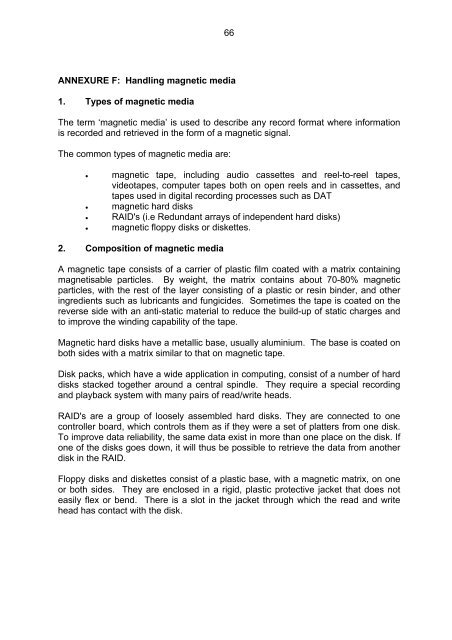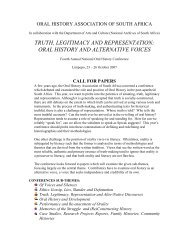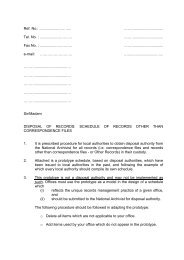managing electronic records in governmental bodies - National ...
managing electronic records in governmental bodies - National ...
managing electronic records in governmental bodies - National ...
Create successful ePaper yourself
Turn your PDF publications into a flip-book with our unique Google optimized e-Paper software.
66<br />
ANNEXURE F: Handl<strong>in</strong>g magnetic media<br />
1. Types of magnetic media<br />
The term ‘magnetic media’ is used to describe any record format where <strong>in</strong>formation<br />
is recorded and retrieved <strong>in</strong> the form of a magnetic signal.<br />
The common types of magnetic media are:<br />
• magnetic tape, <strong>in</strong>clud<strong>in</strong>g audio cassettes and reel-to-reel tapes,<br />
videotapes, computer tapes both on open reels and <strong>in</strong> cassettes, and<br />
tapes used <strong>in</strong> digital record<strong>in</strong>g processes such as DAT<br />
• magnetic hard disks<br />
• RAID's (i.e Redundant arrays of <strong>in</strong>dependent hard disks)<br />
• magnetic floppy disks or diskettes.<br />
2. Composition of magnetic media<br />
A magnetic tape consists of a carrier of plastic film coated with a matrix conta<strong>in</strong><strong>in</strong>g<br />
magnetisable particles. By weight, the matrix conta<strong>in</strong>s about 70-80% magnetic<br />
particles, with the rest of the layer consist<strong>in</strong>g of a plastic or res<strong>in</strong> b<strong>in</strong>der, and other<br />
<strong>in</strong>gredients such as lubricants and fungicides. Sometimes the tape is coated on the<br />
reverse side with an anti-static material to reduce the build-up of static charges and<br />
to improve the w<strong>in</strong>d<strong>in</strong>g capability of the tape.<br />
Magnetic hard disks have a metallic base, usually alum<strong>in</strong>ium. The base is coated on<br />
both sides with a matrix similar to that on magnetic tape.<br />
Disk packs, which have a wide application <strong>in</strong> comput<strong>in</strong>g, consist of a number of hard<br />
disks stacked together around a central sp<strong>in</strong>dle. They require a special record<strong>in</strong>g<br />
and playback system with many pairs of read/write heads.<br />
RAID's are a group of loosely assembled hard disks. They are connected to one<br />
controller board, which controls them as if they were a set of platters from one disk.<br />
To improve data reliability, the same data exist <strong>in</strong> more than one place on the disk. If<br />
one of the disks goes down, it will thus be possible to retrieve the data from another<br />
disk <strong>in</strong> the RAID.<br />
Floppy disks and diskettes consist of a plastic base, with a magnetic matrix, on one<br />
or both sides. They are enclosed <strong>in</strong> a rigid, plastic protective jacket that does not<br />
easily flex or bend. There is a slot <strong>in</strong> the jacket through which the read and write<br />
head has contact with the disk.
















